Abstract
The modern world is moving towards a zero-emission economy; therefore, various actions are being taken to reduce the share of fossil fuels in energy production. The article examines the potential for the continued expansion of photovoltaic farms, with a special emphasis on farms utilising east–west panel orientation. The east–west orientation is an innovative solution with many advantages over the traditional north–south arrangement. The paper also makes a detailed assessment of the photovoltaic farm environment by applying two analyses based on the following factors: Political, Economic, Social, and Technological (PEST) and Demographic, Economic, Environmental, Political, Legal, Informational, Social, and Technological (DEEPLIST) factors. This is followed by an insightful, comprehensive review of the most important factors that contribute to the efficiency of photovoltaic installations, namely site conditions, existing infrastructure, and ability to connect to the electricity grid. The paper also devotes space to an analysis of daily energy price changes that affect the economic efficiency of the installation and discusses the potential for energy storage in the context of photovoltaic farms. The development of photovoltaics also requires investing in energy storage. All discussed issues fall within the scope of photovoltaic farm development and optimal use of energy resources.
1. Introduction
Electricity is today a vital factor in people’s lives and in the operation of the economy. In today’s households, especially in Poland, electricity generated from renewable energy sources (RESs) is increasingly displacing traditional energy sources such as coal and natural gas [1]. This helps to reduce harmful CO2 emissions as well as particulate matter and smog [2]. The industry is increasingly taking advantage of renewable energy sources that represent a growing share of the energy mix [3]. In 2022, these made up over 21% of the energy mix in Poland [4]. The availability, cost, and reliable supply of energy have a significant impact on the operation of businesses, which translates directly into economic development [5,6]. The energy sector is shifting away from fossil fuels towards renewable energy sources. In many countries, the share of RES energy is steadily increasing. RES energy is displacing conventional energy sources to achieve a zero-emission economy [7].
In light of these issues and the advancing climate change, resulting in EU and national legislation, renewable energy sources are becoming a viable alternative to grid-supplied energy, which in Poland, comes mainly from fossil fuels [8]. Figure 1 shows the individual energy sources in the electricity generation structure in Poland in 2022.
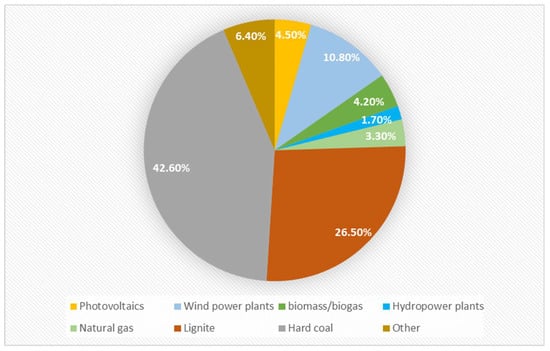
Figure 1.
Electricity production in Poland. Source: [9] https://globenergia.pl/ponad-21-energii-pochodzilo-z-oze-miks-energetyczny-i-struktura-produkcji-energii-w-polsce-w-2022-r/ (accessed on 16 October 2023).
From Figure 1, it can be seen that in Poland, electricity production is mainly based on hard coal (42.6%) and lignite (26.5%); however, renewable energy sources (21.2%) have an increasing share. Moreover, photovoltaics is the most popular and socially accepted of all alternative energy solutions, such as windmills, biomass/biogas, and hydroelectric power plants. [10]. Such a high degree of public favour towards this energy source is driven, among other things, by numerous financial support programmes to achieve a long-term reduction in energy costs. Growing ecological awareness and the desire to care for nature are extremely important, especially because solar energy is perceived as the most sustainable and environmentally friendly source of renewable energy [4]. Photovoltaic (PV) development is illustrated in Figure 2, showing aggregate data on the growth of the installed capacity of power plants in Poland between 2015 and 2021.
Figure 2 shows clearly that the installed capacity practically doubled year-to-year in the period from 2015 to 2021. The increase was seen mostly in home micro-installations, representing around 75% of the total installed capacity, with the remaining 25% accounting for small installations and installations exceeding 1 MW [11]. The huge success of micro-installations is primarily due to their ease of installation, easy hook-up to the home mains grid, as well as near-unlimited scalability. This means that photovoltaic installations may in theory consist of a single module with an output of no more than 250 W. Even a small number of installed modules bring tangible economic benefits to households by enabling them to reduce electricity bills, while also becoming partially or totally independent from energy suppliers [12]. Against the background of this, a new consumer group has emerged, which uses and produces energy at the same time. The term prosumer has been coined as a portmanteau of consumer and producer to describe this group [13,14].
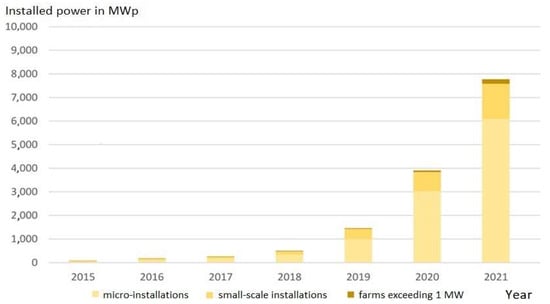
Figure 2.
Cumulative installed photovoltaic capacity in Poland [MW]. Source: own elaboration based on [12] ARE Monthly Bulletin, Statistical Information, and Electricity, www.are.waw.pl, Photovoltaic Market in Poland 2022, Institute of Renewable Energy, Warsaw 2022.
The balance of costs and benefits in the case of photovoltaic installations is different for each user, which is why it is essential to look at all aspects of PV system use. The crucial aspect is the location of panel installation. Site and orientation surveys have shown that a south-facing orientation was correct as well as established by long-standing practice. Because of this, other arrangements are not even taken into account. This approach effectively crowds out all other solutions without proper consideration at the project planning stage.
This paper presents alternative options for the installation of photovoltaic modules, particularly an east–west module arrangement that aims to spread energy production over two peaks, in the morning and in the afternoon. The installation under discussion is characterised by the location of the modules at a lesser angle of inclination than would be the case for south-facing modules. Also, and more importantly, the structure must be aligned with the east–west direction [15]. The paper closes with a discussion of potential benefits of differently orientated farms and the modifications in comparison with southern-oriented sites.
The paper shows an innovative approach to installing photovoltaic panels in an east–west arrangement, which is much more advantageous than the previously widely used north–south arrangement. Thanks to this, the direction of development of photovoltaic farms for the coming years is indicated. It is also shown how important the location of photovoltaic farms in the geo-spatial location is. It is presented how to influence economic efficiency by selling the produced energy at the right hours at the best price thanks to the use of energy storage facilities. There are not many analyses related to the new settlement system in the literature on the subject, so this research fills the research gap related to the effectiveness of using photovoltaics in new conditions.
The article consists of an introduction, three research chapters, a conclusion, and a recommendation. The research chapters deal with the review and verification of the literature, the analysis of the environment of photovoltaic farms and hourly energy prices, and the aspect of energy storage.
2. Materials and Methods
The research was carried out using the method of primary and secondary research. Primary research consisted of research techniques without intervention and was based on the authors’ own observations. The authors observed photovoltaic installations built according to the south–north orientation, analysed the advantages and disadvantages of such a system, and analysed photovoltaic panel systems with an east–west orientation. Thanks to the observations made, it was possible to observe phenomena occurring in the analysed cases. The second part of that study was conducted using desk research. This method was used to analyse, interpret, and formulate conclusions based on collected data [16,17]. The study used numerous materials from various sources, i.e., libraries, repositories, and the Internet. The research scrutinised a substantial body of scholarship in the form of articles, books, reports, and papers with a high impact factor. The materials referenced in this paper were carefully reviewed for scientific and factual accuracy.
With desk research, it was possible to examine a considerable body of data and information in the field of photovoltaics, focusing specifically on small installations, PV farms, energy production profile, as well as impact factors regarding energy efficiency and storage. Figure 3 below shows the process of data collection and analysis for the study.
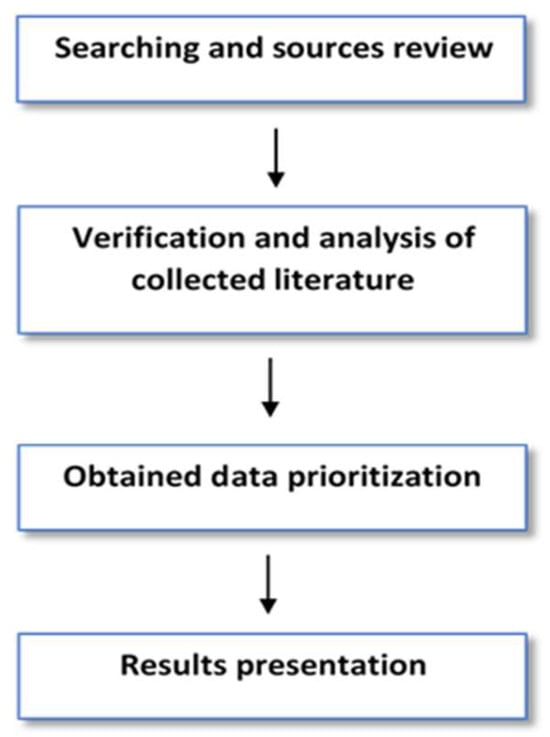
Figure 3.
Verification and analysis of the collected materials. Source: The authors’ own work.
The selected research approach is frequently employed in scientific investigations. A critical component of desk research involves a careful verification of information and data to be used. In order to choose publications for analysis, it is essential to thoroughly evaluate the scholarly value of their contents, the standing of the journals, as well as the significance and influence of the authors within the scientific community. Therefore, in the desk research study, the researchers’ attention focused on detailed analysis, validation, and verification of the sources used.
The research methods used allowed the research to be carried out and divided into several stages, namely (1) conducting observations and developing observations and conclusions regarding the orientation of photovoltaic panels as well as the impact of the location of the farms on their work efficiency and (2) conducting a desk research study, which allowed for the performance of analyses and calculations related to economic efficiency and assessment of the impact of the macroeconomic environment (PEST and DEEPLIST analyses), hourly price distribution, and importance of energy storage.
3. Literature Review
The literature review presented in Table 1 constitutes a valuable source of information, allowing for an in-depth exploration of the key scientific texts related to the field of photovoltaics, as well as a map of the knowledge domain associated with this research area. The literature review plays a significant role in conducting research, enabling an understanding of current achievements, trends, and challenges in the scientific domain of photovoltaics.

Table 1.
Selected scientific paper concerning with photovoltaic issues.
4. Results and Discussion
The desk research results highlight the importance of various aspects of photovoltaic farms. These include site layout, ability to connect to the power grid, module orientation in relation to sunlight, and hourly fluctuations in energy prices. Another important element is the analysis of environmental factors presented in the form of the DEEPLIST [30]. For photovoltaic farms, terrain plays a key role. The correct terrain used for the installation of photovoltaic panels has a direct impact on the efficiency of energy generation. Factors such as shading, slope, and location can affect the overall performance of a photovoltaic system [31]. This highlights the importance of careful site selection to optimise energy production. The location of photovoltaic modules in relation to the sun is another important determining factor for energy production. Proper positioning maximises exposure to the sun and therefore energy production. The angle and orientation of the modules play a significant role in harnessing the full potential of solar radiation [32].
Hourly fluctuations in energy prices highlight the importance of time in energy generation and consumption. Taking advantage of peak demand periods can significantly affect the economic viability of PV farms. Adapting energy production to periods of higher energy prices can increase the financial return on investment [33].
Another key factor is the connection of photovoltaic farms to the grid. Assessing potential challenges and connectivity is key to seamless integration with existing energy infrastructure [22]. The ability to connect to the grid affects not only the operation of the farm, but also the wider issues related to the energy distribution network [34,35].
Furthermore, an in-depth analysis of the PV farm’s surroundings is extremely important, as shown with DEEPLIST. Environmental, economic, political, and social factors shape the overall feasibility and sustainability of PV projects. A holistic approach to these factors allows for a comprehensive understanding of the potential challenges and benefits of the project. Furthermore, the DEEPLIST study highlights the importance of a comprehensive assessment of the impact of the surrounding environment on photovoltaic projects. Taking these insights into account is key to making informed decisions and successfully implementing sustainable PV initiatives [27].
A potential avenue for future research would involve a more comprehensive exploration of renewable energy storage and an analysis of specialised management techniques within the photovoltaic industry, focusing on photovoltaic farm management.
4.1. Environmental Analysis of Photovoltaic Farms
The construction of a photovoltaic farm affects both the immediate surroundings of the project site and a number of more distant areas unrelated directly to the site [22]. Before committing substantial financial resources to construct a photovoltaic farm, it is essential to conduct a strategic analysis of the project. This analysis should consider various factors, both direct and indirect, that can impact the investment. Examining the macro-environment in which the company operates yields crucial insights into potential opportunities and threats. It also enables an assessment of the company’s present and future positioning within this environment [36,37]. External factor analysis can be described as the process of identifying and examining changes, trends, and patterns within the company’s external environment, with the aim of formulating a strategic development plan [38]. Among the most commonly used is a PEST analysis, which aims to verify the impact of key factors (Political, Economic, Social, and Technological factors) on the operation of a project [39]. However, the challenges faced by modern companies require a deeper and broader analysis focusing on other aspects of the macro-environment. This is exemplified by DEEPLIST, which is often seen as a more sophisticated alternative to PEST [40]. This analysis will focus on the following factors: Demographic, Economic, Environmental, Political, Legislative, Informational, Social, and Technological [27].
The Table 2 shows the baseline DEEPLIST analysis for the development of a photovoltaic farm.

Table 2.
DEEPLIST analysis for an investment related to the construction of a photovoltaic farm.
4.2. Analysis of Impact Factors Relating to Installation Efficiency
While a southern exposure is the most prevalent and often the right choice for photovoltaic panels, it is also worth considering the feasibility and effectiveness of an east–west panel orientation, particularly for new installations. In specific situations, this east–west orientation might offer greater efficiency [15]. Such an orientation could be used in the following cases:
4.3. Terrain and Existing Infrastructure
The growing popularity of PV installations has led to the evaluation of a wide range of locations as potential sites for deploying photovoltaic modules. This includes agricultural and industrial plots with varying terrain characteristics. They are often considered mainly because of their location in relation to electricity lines and connection possibilities [46]. The factors given have a significant impact on the feasibility of fitting photovoltaic modules. Structures and irregularly shaped plots of land are an important element in this respect.
It is very common for buildings to have a north–south orientation. Assuming that these are gabled-roof buildings, it is reasonable to justify the arrangement of the panels in an east–west orientation [47]. Figure 4 below shows what the alignment of the modules would look like in southern exposure (left side) and east–west exposure (right side).
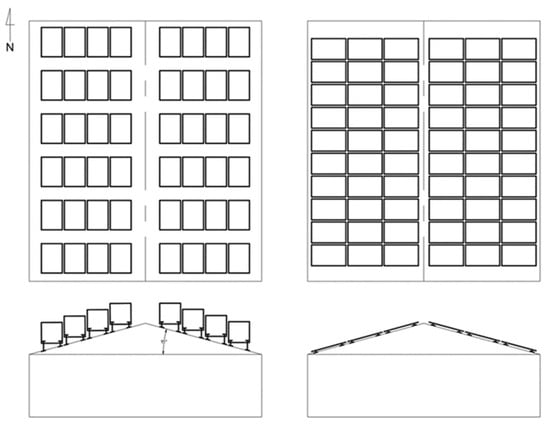
Figure 4.
Position of modules in different exposure arrangements. Source: the authors’ own work.
This arrangement of the panels (east–west) allows more of the roof area to be used. This is shown by Figure 4 and Figure 5, where for the east–west exposure, it was possible to mount an extra 12 panels.
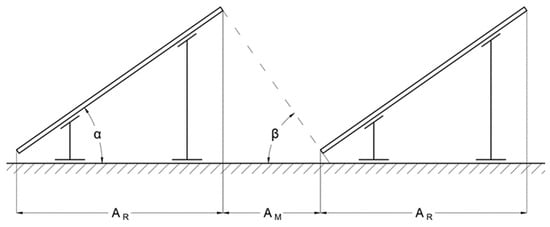
Figure 5.
Rooftop arrangement of modules. Source: the authors’ own work. Symbols: α = angle of inclination of the panels; β = angle of incidence of solar rays; AR = length of module in base projection; and AM = length of incident shadow.
Furthermore, the east–west layout will offer cost advantages in terms of panel installation and maintenance. The cost savings in this configuration result from the installation of fewer frames needed to support the structure [15]. Of course, in practical situations, it is quite uncommon for building structures to align perfectly along the north–south axis. Other crucial considerations include the roof pitch, the optimum module angle, and the constraints imposed by the presence of features like chimneys, air handling units, and roof windows. All these elements have a significant impact on the final assessment of a particular solution [48,49].
Aesthetic qualities are a separate issue, but they are nonetheless important in some cases. The requirement for a strict southern orientation can significantly detract from the visual aesthetics of the development, which might not be an acceptable feature for certain investors on specific sites.
It is notable that photovoltaic systems perform most efficiently when facing south—the best exposure to the sun [15]. It is also known that sun rays illuminate the Earth at different angles at different times of the day and year, which affects energy production. Solar trackers (also known as a tracking system or solar tracking system) are used to minimise this. It is a design that allows the photovoltaic installation to align itself in an ideal position relative to the sun. To address this issue, specialised devices are used with sensors or global positioning system (GPS) technology. These devices determine the optimal position of the panels in relation to the sun at any given time and adjust their orientation accordingly. Trackers are powered by electricity from photovoltaic panels [50,51].
The layout of the project site is another and particularly important aspect for photovoltaic farm construction (the plot’s shape available for build-up, the inclination of the land surface, and the existing structures such as access roads and access to utilities.) The ramifications for the installation of photovoltaic modules on a specific parcel of land are similar to those applicable to structures described in the previous section [52].
4.4. Potential for Connection to the General Electricity Grid
The electricity transmission or distribution company is obliged to enter into a grid connection agreement with applicants seeking connection on a fair and equal basis. Furthermore, it must prioritize the connection of renewable energy source installations. This obligation applies only where it is technically and economically feasible to provide a mains connection and as long as connection and transmission conditions are met. The electricity company is obliged to issue connection conditions within the time limit set out in the law. Connection conditions are valid for two years from the date of issue [53].
If there are no technical or economic prerequisites for the connection capacity outlined in the application for determining the connection conditions for a renewable energy source installation, the energy company must notify the applicant of the available connection capacity for which these conditions can be met [54].
The applicant must file an application with the electricity company (operating the grid to which a connection is sought) for determining the grid connection conditions. A fee of PLN 30,000 (7100 USD) per MW is charged for connecting renewable electricity sources to the grid [55].
Technical requirements for connecting a RES:
Equipment, installations, and networks to be connected must meet technical and operational requirements ensuring:
- operational security of the power supply system;
- protection of the power supply system against damage caused by inappropriate operation of connected equipment, installations, and networks;
- protection of connected equipment, installations, and networks against damage in the event of failure or the introduction of restrictions on energy consumption or supply;
- compliance at the point of connection of equipment, installations, and networks with electricity quality parameters;
- compliance with environmental requirements;
- the ability to measure the quantities and parameters necessary for network operation and billing for energy consumed [56].
Equipment, installations, and networks must also meet the requirements set out in separate regulations, in particular, the construction law, the law on protection against electric shock, the law on fire protection, the system of assessment of conformity, and the law on energy production technology [57].
When connecting a micro-installation to the electricity grid, it is required that the equipment included in the micro-installation is certified in accordance with the relevant Polish standards and European Parliament and Council directives. The infrastructure required for operation also includes inverters and all kinds of structural components. This type of investment is usually characterised by an output ranging from a few tens of kilowatts to even several megawatts. Photovoltaic farms are usually connected to electricity grids with a rated voltage not exceeding 110 kV.
Additionally, existing legislation introduces legal and technical restrictions to protect the interests of private individuals neighbouring the sources, as well as the stability of the power supply system [58].
Unfortunately, with a lack of clarity in the law and an underdeveloped power supply infrastructure, it is difficult, if not impossible, in some areas to meet all the legal and technical requirements for renewable energy sources. The major problems of energy distribution networks are compounded by a number of factors that comprehensively affect the inefficient and uneven prosperity of the entire infrastructure. Among the most important are:
- -
- voltage peaks, caused by uneven load on the inverters;
- -
- voltage collapses, caused by insufficient energy production from photovoltaic modules;
- -
- crossing the PST indicator (short-term flicker severity value) at one customer causes flickering of the light at the other customers;
- -
- crossing the PLT indicator (long-term flicker severity value) can cause damage to household appliances;
- -
- rapid voltage changes lasting more than 1 s, crossing the RVC indicator (Rapid Voltage Change);
- -
- multiphase interruption, consisting of an interruption in the supply of electricity [59].
4.5. Daily Energy Price Differences
One of the factors that demands particular attention in the analysis of panel deployment is addressing the considerations related to billing the electricity supplied to the national grid system. As of 1 July 2022, under EU Directive 2019/944 [60], net billing applies as opposed to previous legislation. One of the aims of such a solution is, in part, to incentivise energy producers to engage in energy storage, thereby contributing to a more balanced energy supply to the grid during billing periods. This includes storing energy, which in turn directly impacts the energy infrastructure [61]. The installation of energy storage facilities stabilises and increases the flexibility of RES energy systems. The choice of energy storage depends on the operating parameters and, above all, on the needs of the user. Factors that impact the operation of storage facilities embrace load patterns, power origins, and economic aspects of energy production, including efficiency, location, environmental considerations, technical conditions, and legal regulations [62]. Nowadays, energy storage facilities are installed in places where there is no grid stability. In countries where the market for energy services has been liberalised, energy storage facilities are used to regulate fluctuations in energy production and consumption [63]. In Poland, the first steps are currently being taken to install energy storage facilities, but the associated legislation is not yet fully developed. Energy storage presents a significant obstacle for the contemporary energy market in Poland. Based on the storage purpose and technology employed, it can be categorised into multiple fundamental forms: chemical, electrical, electrochemical, mechanical, pressure, and thermal [64]. Moreover, electricity stored from photovoltaics can be utilised by households such as for warming water [65].
Net billing is a new prosumer billing system that has been in operation since April 2022 and involves surrendering unused surplus energy to the grid at a set price and buying back energy at the prices of the energy distributor if there is a shortfall in the energy produced from the prosumer’s installation. Currently, net billing is on a monthly basis, which does not really have a particular impact on prosumers’ or producers’ energy storage activities [66,67]. This is due to the unpredictability of energy prices from one billing period to the next. Figure 6 shows the monthly price fluctuations from 2016 to 2023.
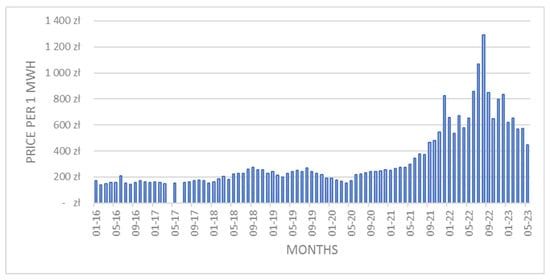
Figure 6.
Distribution of energy prices in PLN/MWh on a monthly basis in the years 2016–2023. Source: the authors’ own work based on https://energy.instrat.pl/ (accessed on 21 June 2023).
Based on the data (Figure 6), there are no clear trends in energy price fluctuations; these are spread relatively evenly throughout the year. This clearly demonstrates that the storage of energy produced from photovoltaic farms is not economically viable. The exception is 2022, where prices rose dramatically.
The analysis of daily energy price fluctuations in 2022 shows significant fluctuations in energy prices throughout the day, where hourly price differences started to increase. This is shown in Figure 7.
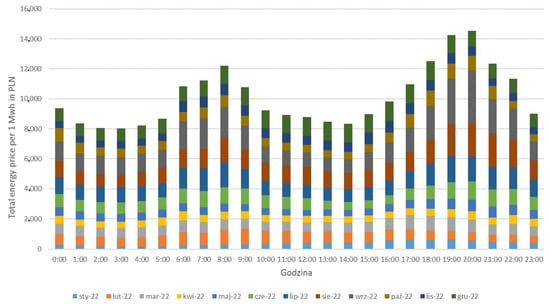
Figure 7.
Distribution of energy prices in PLN/MWh by hour in 2022. Source: https://energy.instrat.pl/ (accessed on 3 July 2023).
Two daily price lows are shown on the graph—in the 01:00 a.m. to 04:00 a.m. and 01:00 p.m. to 02:00 p.m. periods. In contrast, demand peaks at 08:00 a.m. and from 07:00 p.m. to 08:00 p.m. The graph clearly shows that during the morning and evening hours, the demand for energy is the highest and, consequently, the price per MWh is the highest. This means that east–west-oriented farms will produce energy and sell it at a significantly higher price than south-oriented farms, whose peak production is at 12:00 p.m.
The following graph shows the daily fluctuation of energy prices on 3 and 15 June 2023.
By examining the hourly price fluctuations on the Polish Power Exchange from the start of June 2023, it became evident that previous patterns are shifting. Hourly price volatility is increasing, indicating that energy storage is becoming economically viable. Based on data from the day-ahead market on the Polish Power Exchange, it can be seen that since the beginning of June 2023, the difference between the maximum and minimum prices per MWh is often doubled, and the gap widens with each passing day of the month [68]. Of course, during certain days, the price fluctuations are not as drastic (they do not increase linearly), but a price difference remains visible. Figure 8 and Figure 9 show significant price spikes in the evening hours (from 5 p.m.), while the period from 1 a.m. to 9 p.m. exhibits a relationship between price and volume of available energy. As volume decreases during these hours, the price increases, showing that energy supply and demand are interdependent.
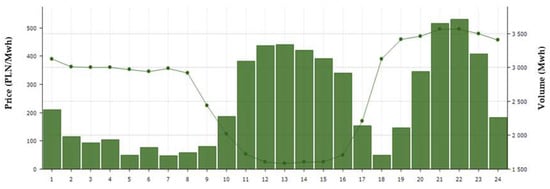
Figure 8.
Daily energy price fluctuation and volume on 3 June 2023. Source: Polish Power Exchange (1 August 2023) (exchange rate PLN/USD).
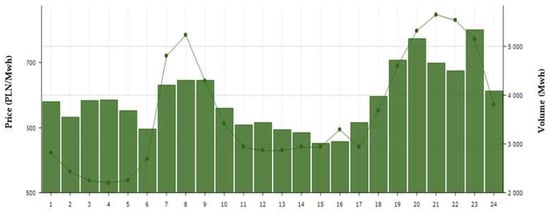
Figure 9.
Daily energy price fluctuation and volume on 15 June 2023. Source: Polish Power Exchange (1 August 2023) (exchange rate PLN/USD).
The change in the billing system and the transition to hourly billing will take place in Poland on 1 July 2024. This will mean for prosumers that, in the case of maximum production during midday hours, the energy produced will be sold to the grid at minimum daily rates. In the case of existing installations, it will be possible to improve the efficiency of the investment by equipping the system with energy storage. However, these solutions require high investment outlays. Assuming an approximate cost of energy storage of approximately USD 610–670 /kWh [69], the costs required for a small 250 kWp installation will—assuming energy storage of only 2 h—amount to approximately PLN 1,250,000 (USD 310,000). Despite the high investment outlays, however, energy storage facilities will form an integral part of future photovoltaic farms, whether south- or east–west-oriented, as they will go a long way towards relieving the load on power lines, making more efficient use of the energy produced from the sun. It will also be possible to sell the energy produced at peak demand times [64,70].
5. Conclusions
This paper demonstrates that PV plays an important role in the energy policy of Poland and the European Union. In 2022, photovoltaic installations accounted for 4.5% of Poland’s total energy production, making it the second-most-popular renewable energy source after wind energy (10.8%) [9]. Improved efficiency in the use of generated energy and more sustainable operation of photovoltaic power plants can contribute to strengthening the energy infrastructure and increasing the country’s energy independence. In the context of this issue, concepts such as photovoltaic farms and energy storage appear complex and multifaceted. Maximising the use of these technologies can bring numerous benefits, including increased energy efficiency, grid stability, and reduced greenhouse gas emissions. Therefore, the continued development of PV technology and its integration with energy storage should be seen as priorities in the move towards a sustainable energy in the future.
As regards the prosperity of photovoltaic farms, the following final conclusions can be drawn:
- Hourly fluctuations in energy prices affect the profitability of photovoltaic farms, as the price for each MWh produced varies according to the current supply and demand for electricity.
- Energy storage makes economic sense with sustained fluctuations in energy prices, allowing for the sale of energy produced at price peaks. This means that generated energy is put to better use than if there was no storage. Furthermore, storage facilities play a beneficial role in enhancing the robustness of Poland’s energy infrastructure. Through energy storage, they alleviate the burden on the infrastructure.
- The east–west orientation of photovoltaic farms is a good and cheaper alternative to energy storage. A farm with this orientation allows for energy production in the morning and afternoon when energy prices can compete with power supplied by farms with southern exposure.
- The DEEPLIST analysis presents the key factors in the selection and operation of photovoltaic farms.
6. Recommendation
The study recommends the introduction of energy storage in photovoltaic systems. Energy storage facilities are a key step in the development and optimisation of solar energy use. The use of energy storage facilities will enable optimum use of solar energy. Storage of electricity generated during the day that can be used at night or during cloudy days. This makes the system more efficient and self-sustaining. In addition, the use of energy storage reduces energy costs. Electricity storage facilities accumulate energy generated during high-production hours and then use it during periods when energy costs are high (e.g., during peak hours). Energy storage facilities help to stabilise the power grid through their ability to store surplus energy at low-demand times and use it at times of high loads. This approach helps smooth out variations in both energy production and consumption, mitigating grid overload during peak periods and compensating for unexpected fluctuations in production from renewable sources like photovoltaics. This helps to keep the voltage and frequency steady, minimising the risk of faults and ensuring smooth operation of the entire power system.
Another recommendation is for photovoltaic systems to use trackers. The use of trackers brings with it a number of benefits that improve the efficiency and effectiveness of solar energy production. Tackers boost energy efficiency by dynamically tracking the movement of the sun throughout the day. This solution enables photovoltaic panels to make maximum use of solar radiation during daylight hours, leading to a substantial improvement in efficiency compared to fixed mounting systems. With the ability to track the sun’s movement, trackers set photovoltaic panels in an optimal position relative to the direction of the sun’s rays. This leads to more energy being generated daily, especially compared to fixed mounting systems. In addition, trackers adjust the angle of the panels depending on the season to take maximum advantage of solar radiation in both summer and winter. This results in higher energy production throughout the year.
Author Contributions
Conceptualization, F.C. and P.F.B.; methodology, F.C. and P.F.B.; software, F.C.; validation, F.C. and P.F.B.; formal analysis, F.C.; investigation, F.C.; resources, F.C.; data curation, F.C.; writing—original draft preparation, F.C.; writing—review and editing, F.C. and P.F.B.; supervision. All authors have read and agreed to the published version of the manuscript.
Funding
This research received no external funding.
Data Availability Statement
Not applicable.
Conflicts of Interest
The authors declare no conflicts of interest.
References
- Igliński, B.; Piechota, G.; Kiełkowska, U.; Kujawski, W.; Pietrzak, M.B.; Skrzatek, M. The assessment of solar photovoltaic in Poland: The photovoltaics potential, perspectives and development. Clean Technol. Environ. Policy 2023, 25, 281–298. [Google Scholar] [CrossRef] [PubMed]
- Jäger-Waldau, A.; Kougias, I.; Taylor, N.; Thiel, C. How photovoltaics can contribute to GHG emission reductions of 55% in the EU by 2030. Renew. Sustain. Energy Rev. 2020, 126, 109836. [Google Scholar] [CrossRef]
- EUR 30328 EN; Energy Consumption and Energy Efficiency trends in the EU-28, 2000–2018. Publications Office of the European Union: Luxembourg, 2020.
- Marks-Bielska, R.; Bielski, S.; Pik, K.; Kurowska, K. The Importance of Renewable Energy Sources in Poland’s Energy Mix. Energies 2020, 13, 4624. [Google Scholar] [CrossRef]
- Boratyński, J.; Plich, M.; Przybyliński, M. Krótkookresowe efekty zmian cen energii w polskiej gospodarce. Stud. Prawno-Ekon. 2010, LXXXII, 217–239. [Google Scholar]
- Mukhtarov, S.; Mikayilov, J.I. Could financial development eliminate energy poverty through renewable energy in Poland? Energy Policy 2023, 182, 113747. [Google Scholar] [CrossRef]
- Anika, O.C.; Nnabuife, S.G.; Bello, A.; Okoroafor, E.R.; Kuang, B.; Villa, R. Prospects of low and zero-carbon renewable fuels in 1.5-degree net zero emission actualisation by 2050: A critical review. Carbon Capture Sci. Technol. 2022, 5, 100072. [Google Scholar] [CrossRef]
- Wolniak, R.; Skotnicka-Zasadzień, B. Development of Photovoltaic Energy in EU Countries as an Alternative to Fossil Fuels. Energies 2022, 15, 662. [Google Scholar] [CrossRef]
- Available online: https://globenergia.pl/ponad-21-energii-pochodzilo-z-oze-miks-energetyczny-i-struktura-produkcji-energii-w-polsce-w-2022-r/ (accessed on 16 October 2023).
- Zielony Potencjał Społeczny—Polska i Europa Środkowo-Wschodnia; Badanie IBRiS: Warszawa, Poland, 2020.
- ARE Monthly Bulletin, Statistical Information and Electricity, Photovoltaic Market in Poland 2022; Institute of Renewable Energy: Warsaw, Poland, 2022; Available online: www.are.waw.pl (accessed on 20 August 2023).
- Wicki, L.; Pietrzykowski, R.; Kusz, D. Factors Determining the Development of Prosumer Photovoltaic Installations in Poland. Energies 2022, 15, 5897. [Google Scholar] [CrossRef]
- Gough, M.; Santos, S.F.; Javadi, M.; Castro, R.; PS Catalão, J. Elastyczność prosumenta: Kompleksowy, najnowocześniejszy przegląd i analiza naukometryczna. Energies 2020, 13, 2710. [Google Scholar] [CrossRef]
- Borowski, P.F. Zonal and Nodal Models of Energy Market in European Union. Energies 2020, 13, 4182. [Google Scholar] [CrossRef]
- Khatib, T.; Deria, R. East-west oriented photovoltaic power systems: Model, benefits and technical evaluation. Energy Convers. Manag. 2022, 266, 115810. [Google Scholar] [CrossRef]
- Ortega-Gras, J.-J.; Bueno-Delgado, M.-V.; Cañavate-Cruzado, G.; Garrido-Lova, J. Twin Transition through the Implementation of Industry 4.0 Technologies: Desk-Research Analysis and Practical Use Cases in Europe. Sustainability 2021, 13, 13601. [Google Scholar] [CrossRef]
- Borowski, P.F. Digitization, Digital Twins, Blockchain, and Industry 4.0 as Elements of Management Process in Enterprises in the Energy Sector. Energies 2021, 14, 1885. [Google Scholar] [CrossRef]
- Gu, W.; Ma, T.; Ahmed, S.; Zhang, Y.; Peng, J. A comprehensive review and outlook of bifacial photovoltaic (bPV) technology. Energy Convers. Manag. 2020, 223, 113283. [Google Scholar] [CrossRef]
- Verlinden, P.J. Future challenges for photovoltaic manufacturing at the terawatt level. J. Renew. Sustain. Energy 2020, 12, 053505. [Google Scholar] [CrossRef]
- European Commission, European Green Deal. Available online: https://climate.ec.europa.eu/eu-action/european-green-deal_en (accessed on 20 August 2023).
- Brodziński, Z.; Brodzińska, K.; Szadziun, M. Photovoltaic Farms—Economic Efficiency of Investments in North-East Poland. Energies 2021, 14, 2087. [Google Scholar] [CrossRef]
- Kurowska, K.; Kryszk, H.; Bielski, S. Location and Technical Requirements for Photovoltaic Power Stations in Poland. Energies 2022, 15, 2701. [Google Scholar] [CrossRef]
- Zsiborács, H.; Hegedűsné Baranyai, N.; Vincze, A.; Háber, I.; Pintér, G. Economic and Technical Aspects of Flexible Storage Photovoltaic Systems in Europe. Energies 2018, 11, 1445. [Google Scholar] [CrossRef]
- Bódis, K.; Kougias, I.; Jäger-Waldau, A.; Taylor, N.; Szabó, S. A high-resolution geospatial assessment of the rooftop solar photovoltaic potential in the European Union. Renew. Sustain. Energy Rev. 2019, 114, 109309. [Google Scholar] [CrossRef]
- Iglinski, B.; Flisikowski, K.; Pietrzak, M.B.; Kiełkowska, U.; Skrzatek, M.; Zyadin, A.; Natarajan, K. Renewable Energy in the Pomerania Voivodeship—Institutional, Economic, Environmental and Physical Aspects in Light of EU Energy Transformation. Energies 2021, 14, 8221. [Google Scholar] [CrossRef]
- Chomać-Pierzecka, E.; Kokiel, A.; Rogozińska-Mitrut, J.; Sobczak, A.; Soboń, D.; Stasiak, J. Analysis and Evaluation of the Photovoltaic Market in Poland and the Baltic States. Energies 2022, 15, 669. [Google Scholar] [CrossRef]
- Patuk, I.; Borowski, P.F. Business plan of the company of repair and maintenance outboards and boats–“Technoservice”. World Sci. News 2017, 86, 193–204. [Google Scholar]
- Mostafa Azza, A.A.; Youssef, K.; Abdelrahman, M. Analysis of Photovoltaics in Egypt using SWOT and PESTLE. International J. Appl. Energy Syst. 2020, 2, 11–14. [Google Scholar] [CrossRef]
- Igliński, B.; Skrzatek, M.; Kujawski, W.; Cichosz, M.; Buczkowski, R. SWOT analysis of renewable energy sector in Mazowieckie Voivodeship (Poland): Current progress, prospects and policy implications. Environ. Dev. Sustain. 2022, 24, 77–111. [Google Scholar] [CrossRef]
- Korzeniewska, E.; Drzymała, A.; Szczęsny, A.; Zawiślak, R.; Seme, S. Aspekty prawno-ekonomiczne i ekologiczne dla elektrowni fotowoltaicznych. Przegląd Elektrotechniczny 2019, 95, 69–72. [Google Scholar] [CrossRef]
- Chen, X.M.; Li, Y.; Zhao, Z.G.; Ma, T.; Wang, R.Z. General method to obtain recommended tilt and azimuth angles for photovoltaic systems worldwide. Sol. Energy 2018, 172, 46–57. [Google Scholar] [CrossRef]
- Chen, X.M.; Li, Y.; Zhao, B.Y.; Wang, R.Z. Are the optimum angles of photovoltaic systems so important? Renew. Sustain. Energy Rev. 2020, 124, 109791. [Google Scholar] [CrossRef]
- Rynek Dnia Następnego. Available online: https://tge.pl/energia-elektryczna-rdn (accessed on 20 August 2023).
- Andruszkiewicz, J.; Lorenc, J. Ograniczanie Obciążeń Szczytowych Systemu Elektroenergetycznego przy Wykorzystaniu Zasobów Popytowych Sterowanych Strefami Cenowymi. Available online: http://leonardo-energy.pl/wp-content/uploads/2016/11/Ograniczenie-obciazen-szczytowych-systemu-elektroenergetycznego-przy-wyko.pdf (accessed on 20 August 2023).
- Jiang, S.; Wan, C.; Chen, C.; Cao, E.; Song, Y. Distributed photovoltaic generation in the electricity market: Status, mode and strategy. CSEE J. Power Energy Syst. 2018, 4, 263–272. [Google Scholar] [CrossRef]
- Kozioł, K. Analiza Strategiczna Przedsiębiorstwa na Poziomie Makrootoczenia; Uniwersytet Szczeciński: Szczecin, Poland, 2010; p. 79. [Google Scholar]
- Salim, A.M.; Dabous, S.A. SWOT Analysis of Solar Photovoltaic Systems in Public Housing Projects in the United Arab Emirates. In Proceedings of the 2022 Advances in Science and Engineering Technology International Conferences (ASET), Dubai, United Arab Emirates, 21–24 February 2022; pp. 1–6. [Google Scholar] [CrossRef]
- Penc-Pietrzak, I. Stosowanie Metod Analizy Strategicznej w Planowaniu Strategicznym Przez duże Polskie Przedsiębiorstwa Przemysłowe; Zeszyty naukowe Nr 1126 Politechnika Łódzka: Łódź, Poland, 2012; p. 95. [Google Scholar]
- Ho, J.K.K. Formulation of a systemic PEST analysis for strategic analysis. Eur. Acad. Res. 2014, 2, 6478–6492. [Google Scholar]
- Perera, R. The PESTLE Analysis; Nerdynaut: Avissawella, Sri Lanka, 2017. [Google Scholar]
- Broda, K.; Tora, B. Bezpieczna Utylizacja, czy Recycling PV? Nowa Energia: Gdynia, Poland, 2021. [Google Scholar]
- Sołtysiak, M. Zarządzanie projektem budowy farmy fotowoltaicznej w zakresie pozyskiwania dokumentacji-studium przypadku. Zesz. Nauk. Politech. Częstochowskiej 2019, 33, 222–231. [Google Scholar] [CrossRef]
- Koncesja na Wytwarzanie Energii Elektrycznej (WEE). Available online: https://www.biznes.gov.pl/pl/opisy-procedur/-/proc/8 (accessed on 31 July 2023).
- Ministerstwo Klimatu i Środowiska; Polityka Energetyczna Polski do 2040 r. Available online: https://www.gov.pl/web/klimat/polityka-energetyczna-polski (accessed on 31 July 2023).
- Włodarczyk, R. Analysis of the Photovoltaic Waste-Recycling Process in Polish Conditions—A Short Review. Sustainability 2022, 14, 4739. [Google Scholar] [CrossRef]
- Ordóñez, J.; Jadraque, E.; Alegre, J.; Martínez, G. Analysis of the photovoltaic solar energy capacity of residential rooftops in Andalusia (Spain). Renew. Sustain. Energy Rev. 2010, 14, 2122–2130. [Google Scholar] [CrossRef]
- Yano, A.; Kadowaki, M.; Furue, A.; Tamaki, N.; Tanaka, T.; Hiraki, E.; Kato, Y.; Ishizu, F.; Noda, S. Shading and electrical features of a photovoltaic array mounted inside the roof of an east–west oriented greenhouse. Biosyst. Eng. 2010, 106, 367–377. [Google Scholar] [CrossRef]
- Abdeen, E.; Orabi, M.; Hasaneen, E.S. Optimum tilt angle for photovoltaic system in desert environment. Sol. Energy 2017, 155, 267–280. [Google Scholar] [CrossRef]
- Mehleri, E.D.; Zervas, P.L.; Sarimveis, H.; Palyvos, J.A.; Markatos, N.C. Determination of the optimal tilt angle and orientation for solar photovoltaic arrays. Renew. Energy 2010, 35, 2468–2475. [Google Scholar] [CrossRef]
- Amelia, A.R.; Irwan, Y.M.; Safwati, I.; Leow, W.Z.; Mat, M.H.; Rahim, M.S.A. Technologies of solar tracking systems: A review. In IOP Conference Series: Materials Science and Engineering; IOP Publishing: Bristol, UK, 2020; Volume 767, p. 012052. [Google Scholar]
- Hafez, A.Z.; Yousef, A.M.; Harag, N.M. Solar tracking systems: Technologies and trackers drive types—A review. Renew. Sustain. Energy Rev. 2018, 91, 754–782. [Google Scholar] [CrossRef]
- Martín-Chivelet, N. Photovoltaic potential and land-use estimation methodology. Energy 2016, 94, 233–242. [Google Scholar] [CrossRef]
- Klimek, J. BUDOWA FARMY FOTOWOLTAICZNEJ O MOCY DO 26 MW WRAZ Z NIEZBĘDNĄ INFRASTRUKTURĄ TECHNICZNĄ NA DZIAŁKACH O NR EWID. 17, 18, 28, 29, 31, 60, 61 i 285 W OBRĘBIE Radwanki W GMINIE Margonin; Samorzad: Bydgoszcz, Poland, 2021. [Google Scholar]
- Biznes.gov.pl, Wpis do Rejestru Wytwórców Energii w Małej Instalacji. Available online: https://www.biznes.gov.pl/pl/opisy-procedur/-/proc/820 (accessed on 25 July 2023).
- Skibko, Z. Techniczne i Prawne Możliwości Przyłączania OZE do Sieci Elektroenergetycznej, Elektro.Info Journal 10/2015, Białystok 2015. Available online: https://www.elektro.info.pl/artykul/instalacje-elektroenergetyczne/61430,techniczne-i-prawne-mozliwosci-przylaczania-oze-do-sieci-elektroenergetycznej (accessed on 1 January 2024).
- Ustawa z Dnia 20 Lutego 2015 r. o Odnawialnych Źródłach Energii. DzU z Dnia, 3 April 2015; p. 478.
- Czaja, P. Bezpieczeństwo Pożarowe Instalacji Fotowoltaicznych; SUMA: Leeds, UK, 2021; Volume 150, p. 836. [Google Scholar]
- Kryteria Oceny Możliwości Przyłączenia oraz Wymagania Techniczne dla Mikroinstalacji i Małych Instalacji Przyłączanych do Sieci Dystrybucyjnej Niskiego Napięcia Operatora Systemu Dystrybucyjnego; PGE Dystrybucja S.A.: Lublin, Poland, 2014.
- Kurdyła, R. Influence of photovoltaic installations on the operation of the LV distribution network. Rzesz. Univ. Technol. J. Electr. Eng. 2022, 39, 21–32. [Google Scholar]
- Dyrektywa Parlamentu Europejskiego i Rady (UE) 2019/944 z Dnia 5 Czerwca 2019 r. w Sprawie Wspólnych Zasad Rynku Wewnętrznego Energii Elektrycznej; Dziennik Urzędowy Unii Europejskiej 158/125 z; European Union: Maastricht, The Netherlands, 2019.
- Niklewicz-Pijaczyńska, M. Paradygmat prosumenta wobec aktualnych wyzwań transformacji energetycznej. Folia Iurid. Univ. Wratislav. 2022, 11, 84–101. [Google Scholar]
- Akbari, H.; Browne, M.C.; Ortega, A.; Huang, M.J.; Hewitt, N.J.; Norton, B.; McCormack, S.J. Efficient energy storage technologies for photovoltaic systems. Sol. Energy 2019, 192, 144–168. [Google Scholar] [CrossRef]
- Toledo, O.M.; Oliveira Filho, D.; Diniz, A.S.A.C. Distributed photovoltaic generation and energy storage systems: A review. Renew. Sustain. Energy Rev. 2010, 14, 506–511. [Google Scholar] [CrossRef]
- Rafał, K.; Grabowski, P. Magazynowanie Energii 2021, PAN Journals 1/65/2021. Available online: https://journals.pan.pl/dlibra/publication/136844/edition/119700/content/academia-magazyn-polskiej-akademii-nauk-nr-1-65-energetyka-magazynowanie-energii-rafal-krzysztof-grabowski-pawel-2021?language=en (accessed on 15 July 2023).
- Tahiri, A.; Smith, K.M.; Thorsen, J.E.; Hviid, C.A.; Svendsen, S. Staged control of domestic hot water storage tanks to support district heating efficiency. Energy 2023, 263, 125493. [Google Scholar] [CrossRef]
- Ordóñez, Á.; Sánchez, E.; Rozas, L.; García, R.; Parra-Domínguez, J. Net-metering and net-billing in photovoltaic self-consumption: The cases of Ecuador and Spain. Sustain. Energy Technol. Assess. 2022, 53, 102434. [Google Scholar] [CrossRef]
- Trela, M.; Dubel, A. Net-metering vs. net-billing from the investors perspective—Impacts of changes in RES financing in Poland on the profitability of a joint photovoltaic panels and heat pump system. Energies 2021, 15, 227. [Google Scholar] [CrossRef]
- TGE, Rynek Dnia Następnego. Available online: https://tge.pl/energia-elektryczna-rdn?dateShow=02-06-2023&dateAction=next (accessed on 1 August 2023).
- Ramasamy, V.; Zuboy, J.; O’Shaughnessy, E.; Feldman, D.; Desai, J.; Woodhouse, M.; Basore, P.; Margolis, R. U.S. Solar Photovoltaic System and Energy Storage Cost Benchmarks, with Minimum Sustainable Price Analysis for Q1 2022; National Renewable Energy LaboratoryClean Kilowatts, LLC: Golden, CO, USA, 2022. [Google Scholar]
- Parra, D.; Swierczynski, M.; Stroe, D.I.; Norman, S.A.; Abdon, A.; Worlitschek, J.; O’Doherty, T.; Rodrigues, L.; Gillott, M.; Zhang, X. An interdisciplinary review of energy storage for communities: Challenges and perspectives. Renew. Sustain. Energy Rev. 2017, 79, 730–749. [Google Scholar] [CrossRef]
Disclaimer/Publisher’s Note: The statements, opinions and data contained in all publications are solely those of the individual author(s) and contributor(s) and not of MDPI and/or the editor(s). MDPI and/or the editor(s) disclaim responsibility for any injury to people or property resulting from any ideas, methods, instructions or products referred to in the content. |
© 2024 by the authors. Licensee MDPI, Basel, Switzerland. This article is an open access article distributed under the terms and conditions of the Creative Commons Attribution (CC BY) license (https://creativecommons.org/licenses/by/4.0/).